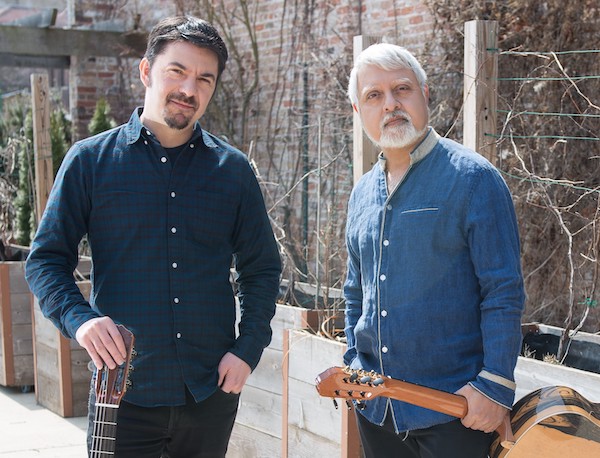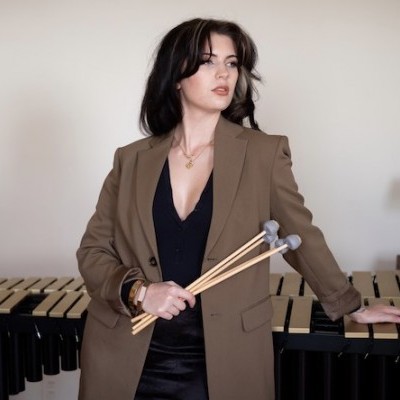Jun 3, 2025 11:25 AM
In Memoriam: Al Foster, 1943–2025
Al Foster, a drummer regarded for his fluency across the bebop, post-bop and funk/fusion lineages of jazz, died May 28…

Goran Ivanovic (left) and Fareed Haque combine myriad idioms within jazz improvisation for IndoBalkan (Delmark).
(Photo: Courtesy Delmark)Chicago guitarists Fareed Haque and Goran Ivanovic started working together during the mid 1990s—just after Ivanovic was Haque’s student at Northern Illinois University. But a 15-year gap between recorded collaborations ensued, as each performer saw touring demands around the world increase. IndoBalkan (Delmark) has rectified that. Mostly a duo recording with percussionist Juan Pastor contributing to two tracks, the sparse format highlights how the guitarists combine myriad idioms—more than the national identities referenced in the album’s title—into jazz improvisation.
The following has been edited for length and clarity.
Getting back together to record after such a long time apart, what were some of the biggest surprises or challenges?
Fareed Haque: Both of us have written a lot of music between then and now. It was great to get together and play a bunch of music that reflects the evolution that we had. Goran was more firmly in Eastern European or Balkan music in the ’90s and early 2000s when we were playing together. And I was more squarely in a fusion world. Since that time, I’ve played a lot of straightahead jazz, a lot of classical music, a lot of world music. Goran has played with a band, his music has broadened, become more eclectic; some tunes he wrote have a Latin feel, but still use odd meters that are part of the Balkan sound. I’ve written a lot of music that is more classical in nature. A lot of those sounds made it into the new music. Not sure that [there were] many challenges. In the sense of difficulties, the music we’ve written is a shit ton harder. In the past, Goran would come up with a riff, I would come up with second guitar part and wham-bam, that’s done. This time, all the music is more through-composed, more intricate, more difficult, harder stuff. That being said, we were comfortable enough to do that. It hasn’t been a challenge as much as it’s cool.
Goran Ivanovic: Both of us have developed as composers, as musicians. The records we had done were nice records, but we didn’t want to revisit that kind of style of composing. So, I thought what would be a good way to move in a different direction, go a little less folky, more modern, modern classical with jazz improvisation. It developed when you’re not playing with someone for 10, 15 years, you write a couple tunes that emotionally remind you of past collaborations. There was always this connection to him and tunes we did, but I also wanted a fresh start. I remember writing a couple tunes with big, long melodic lines and complex rhythms—irregular, 5, 7, 9, 11—and build on top of that. We worked on a bunch of tunes and had a good selection—what we wanted to put out on the record and we keep playing live at the shows. It starts feeling like you have 45 minutes of strong materiala. Some are more like a salad, some are more like a steak dinner, some are more like dessert.
What are the advantages of playing acoustic guitar duos, especially with nylon-string guitars, compared to other guitars?
FH: Acoustic music has so many different colors. You can play—especially a nylon string—from a flamenco to Arabic sound to a Balkan sound to a standard baroque or classical. All these different timbres, colors and energies that you can bring to it.
GI: The tone is much shorter compared to steel string or electric. You have to arrange things in such a way that if one of us is playing chords, arpeggiated chords, if melody is slow, you don’t want to bury the melodic line. You have to arrange every tune so one guitar does not bury the other—either through repetition of a single melodic line or adding certain technical things to keep it melodic, rather than having it buried. That’s one challenge, but it’s a fun challenge.
How has the dialog between you evolved on a harmonic level since 15 years ago?
FH: Initially, Goran was coming more from a straight classical background, so changing keys, chords was not as comfortable for him, and over the years he’s gotten really comfortable with it. We’re not nearly as limited harmonically as we might have been 15 years ago. There is a lot of harmonic interplay, and a lot of pieces I wrote are more harmonically challenging. He’s comfortable with that, and we’re able to be more adventuresome.
GI: It’s kind of like watching a black-and-white movie and then suddenly there’s color, or suddenly there is surround sound in the movies, then there is 3D. I started using harmony as an expansion of my feelings and understanding of music. In the past, I was happy writing tunes that are harmonically very simple, a few chords and improvised solos. But now, I’m not only putting a lot of chords in my music, but also arpeggiating some things, and the chords will change in the first half of one measure, from one chord to another chord. That’s an impressionistic style. We’re playing and the harmony becomes very complex ... . That’s why it’s exciting to hear. It’s not something that’s very common, especially now that we’re in a classical guitar setting. I worked for many years to make it exciting to me, just a natural progression of things.
While you’re still bringing in music from across South Asia, Latin America and Europe to what you do, has your understanding of the idioms changed over the years?
FH: We are not so scholarly about what we do. Sometimes, I sound scholarly because I teach. It’s when you grow up in an experience, it’s so much more instinctual and there are definitely folks who are scholarly about this stuff. But we’re not those guys. I wish we were. I love sitting down with different Hindustani musicians, and they’ll go on about stuff and I feel like the student. Then, when I write something that uses those ideas, it tends to be more referential. It’s referencing those ideas. I’m not Hindustani, I’m not South American. I’m from Chicago. Goran is not really a traditionalist or a folk musician in that sense. He’s written a lot of music that reflects his country’s musical traditions. It’s more a modern take on those things.
GI: In all those traditions, you have the swing of the music and that’s the bridge between the classical or Balkan tradition. I can sit down and I can learn a lot of different things because I understand how music breathes, swings. There’s always a common conversation when you’re skilled in the folk styles—but also classical styles. All I can say is it’s always very enjoyable learning something in that kind of style. I like to use a lot of flamenco stuff but I would never call myself a flamenco player. For what I’m writing, that’s perfectly fine as long as there are no flamenco dancers in the house. DB

Foster was truly a drummer to the stars, including Miles Davis, Sonny Rollins and Joe Henderson.
Jun 3, 2025 11:25 AM
Al Foster, a drummer regarded for his fluency across the bebop, post-bop and funk/fusion lineages of jazz, died May 28…

“Branford’s playing has steadily improved,” says younger brother Wynton Marsalis. “He’s just gotten more and more serious.”
May 20, 2025 11:58 AM
Branford Marsalis was on the road again. Coffee cup in hand, the saxophonist — sporting a gray hoodie and a look of…

“What did I want more of when I was this age?” Sasha Berliner asks when she’s in her teaching mode.
May 13, 2025 12:39 PM
Part of the jazz vibraphone conversation since her late teens, Sasha Berliner has long come across as a fully formed…

Roscoe Mitchell will receive a Lifetime Achievement award at this year’s Vision Festival.
May 27, 2025 6:21 PM
Arts for Art has announced the full lineup for the 2025 Vision Festival, which will run June 2–7 at Roulette…

Benny Benack III and his quartet took the Midwest Jazz Collective’s route for a test run this spring.
Jun 3, 2025 10:31 AM
The time and labor required to tour is, for many musicians, daunting at best and prohibitive at worst. It’s hardly…